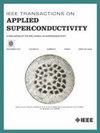Design and Verification of High-Voltage Stator for Grid-Directly-Connected Superconducting Synchronous Condenser
IF 1.7
3区 物理与天体物理
Q3 ENGINEERING, ELECTRICAL & ELECTRONIC
引用次数: 0
Abstract
To achieve a superconducting synchronous condenser (SSC) directly connected to the power grid without the need for a step-up transformer, this article proposes a high-voltage stator topology incorporating cable windings and nonmagnetic teeth. The research addresses key issues such as the topology of cable windings, bending radius verification, slot design, and the structural design of the high-voltage stator. Based on voltage breakdown tests of cross-linked polyethylene (XLPE) sheet samples and the characteristics of the stator windings, an insulation scheme for 35 kV XLPE cables is designed. In addition, a stepped insulation scheme for cable windings is proposed. An electromagnetic design process for the high-voltage stator is outlined, and a field-circuit coupled model is developed for the grid-directly-connected SSC, completing the electromagnetic design for a 30 Mvar, 35 kV SSC. Temperature field simulations for the high-voltage stator are performed, validating the preliminary feasibility of the high-voltage stator from both electromagnetic design and ventilation cooling perspectives. Finally, a prototype of the cable-winding synchronous condenser is developed and tested, and through the withstand voltage test of the cable windings, the preliminary feasibility of the grid-directly-connected SSC is confirmed.直接并网超导同步凝汽器高压定子的设计与验证
为了实现超导同步电容器(SSC)直接连接到电网而不需要升压变压器,本文提出了一种包含电缆绕组和非磁性齿的高压定子拓扑结构。主要研究了电缆绕组拓扑结构、弯曲半径验证、槽设计和高压定子结构设计等关键问题。根据交联聚乙烯(XLPE)片样的电压击穿试验和定子绕组的特性,设计了35kv交联聚乙烯电缆的绝缘方案。此外,还提出了电缆绕组的阶梯式绝缘方案。概述了高压定子的电磁设计流程,建立了与电网直连的SSC的场路耦合模型,完成了30mvar、35kv SSC的电磁设计。对高压定子进行了温度场仿真,从电磁设计和通风冷却两方面验证了高压定子的初步可行性。最后,研制了电缆绕组同步电容器样机并进行了试验,通过电缆绕组的耐压试验,初步证实了电网直连式SSC的可行性。
本文章由计算机程序翻译,如有差异,请以英文原文为准。
求助全文
约1分钟内获得全文
求助全文
来源期刊

IEEE Transactions on Applied Superconductivity
工程技术-工程:电子与电气
CiteScore
3.50
自引率
33.30%
发文量
650
审稿时长
2.3 months
期刊介绍:
IEEE Transactions on Applied Superconductivity (TAS) contains articles on the applications of superconductivity and other relevant technology. Electronic applications include analog and digital circuits employing thin films and active devices such as Josephson junctions. Large scale applications include magnets for power applications such as motors and generators, for magnetic resonance, for accelerators, and cable applications such as power transmission.
 求助内容:
求助内容: 应助结果提醒方式:
应助结果提醒方式:


